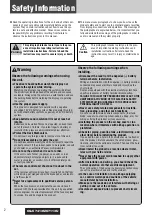
FP51-SL
21
5. Preparations
5.1. Installation
x
Place the unit on an even surface on a pad made of
non-flammable
material. Using the castors move the unit to the intended location.
For better stability, apply the holding breaks on the front casters.
x
Cooling machine, pump motor and electronics produce intrinsic heat
that is dissipated via the venting openings! Never cover these
openings!
x
Keep at least 20 cm of open space on the front and rear venting grids.
x
The place of installation should be large enough and provide sufficient
air ventilation to ensure the room does not warm up excessively
because of the heat the instrument rejects to the environment. (Max.
permissible ambient temperature: 40 °C).
For a fault (leakage) in the refrigeration system, the standard EN 378
prescribes a certain room space to be available for each kg of
refrigerant.
The refrigerant quantity is specified on the type plate.
> For 0.49 kg of refrigerant R507, 1 m
3
of space is required.
x
Do not set up the unit in the immediate vicinity of heat sources and do
not expose to sun light
x
Before operating the unit after transport, wait about one hour after
setting it up. This will allow any oil that has accumulated laterally
during transport to flow back down thus ensuring maximum cooling
performance of the compressor.
5.2. Bath fluids
Caution:
Carefully read the safety data sheet of the bath fluid used, particularly with regard to
the fire point!
If a bath fluid with a fire point of
d
65 °C is used, only supervised operation is possible.
Water:
The quality of water depends on local conditions.
x
Due to the high concentration of lime, hard water is not suitable for temperature
control because it leads to calcification in the bath.
x
Ferrous water can cause corrosion - even on stainless steel.
x
Chloric water can cause pitting corrosion.
x
Distilled and deionized water is unsuitable. Their special properties cause
corrosion in the bath, even in stainless steel.
www.
GlobalTestSupply
.com
Find Quality Products Online at:
















































